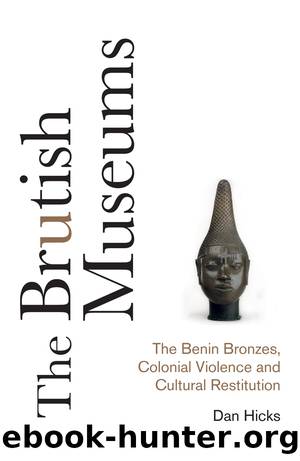The Brutish Museums by Dan Hicks;

Author:Dan Hicks;
Language: eng
Format: epub
Publisher: Book Network Int'l Limited trading as NBN International (NBNi)
The transformation of sacred and royal material culture into not things, but objects, through the twin devices of the market and the museum, constitutes a further dimension to the processes of colonialism in its most modern and violent fin-de-siècle forms as seen in the Benin-Niger-Soudan Expedition.
The Euro-American anthropology museum constitutes a further space of containment, in Fanonâs terms, of chosification in Césaireâs terms, of mummification, statuefication and fetishisation in those of Mbembe. In this transformation of life and substance museums became a key regime of practice through which Africans were dehumanised. Here brutish museums like the Pitt Rivers where I work have compounded killings, cultural destructions and thefts with the propaganda of race science, with the normalisation of the display of human cultures in material form. An act of dehumanisation in the face of dispossession lies at the heart of the operation of the brutish museums. A major part of what is involved here, I want to suggest, can be described as chronopolitics. This involved more than being denied a place in the contemporary world, as was the thesis of Johannes Fabian in his crucial book Time and the Other, although the early modern practice of the nascent anthropological gaze, which collapsed space into time so that it appeared that the further from the metropolis the European travelled, the further back in time they went, until reaching the Stone Age in Tasmania, or Tierra del Fuego, etc.,4 is certainly one element. But more than just the denial of what Fabian called âcoevalnessâ â a verbal assertion that two living human groups were living in incommensurable time periods â there was a double process of material change that was effected through which whole cultures really were stripped of their technologies, had their living landscapes transformed into ruins â and had these moments of violence extended across time, memorialised, through the technology of the anthropology museum.
* * *
The origins of Pitt-Riversâs idea of the typological museum were militarist.5 It is not just that his first collection began in the 1850s as a museum of arms: more than that, it was âhis classification of the museum of weapons, etc.â, wrote Edward Burnett Tylor after seeing its first public display in Bethnal Green, that led Augustus Pitt-Rivers âto form his theoriesâ.6 Pitt-Riversâs account of how to extend a Darwinian conception of the evolution of nature into the much messier, more complex, world of material culture, began with three lectures he gave on âPrimitive Warfareâ at the Royal United Service Institution in 1866 and 1867.7 Pitt-Riversâs interest in arranging weapons by âtypeâ, and then each âtypeâ into hypothetical âseriesâ, was to demonstrate â through public displays in Bethnal Green from 1873, in South Kensington from 1878, and in Oxford from 1884 â how small innovations in design have incrementally significant effects when taking place at scale. Central to Pitt-Riversâs vision of what he called âthe evolution of cultureâ was what he called âthe degenerate descendants of people in a higher phase of cultureâ, where a
Download
This site does not store any files on its server. We only index and link to content provided by other sites. Please contact the content providers to delete copyright contents if any and email us, we'll remove relevant links or contents immediately.
The Japanese by Christopher Harding(1017)
Watercolor With Me in the Forest by Dana Fox(716)
A Theory of Narrative Drawing by Simon Grennan(703)
The Story of the Scrolls by The Story of the Scrolls; the M(694)
Glittering Images: A Journey Through Art From Egypt to Star Wars by Camille Paglia(613)
Boris Johnson by Tom Bower(587)
The Art and Science of Drawing by Brent Eviston(563)
This Is Modern Art by Kevin Coval(561)
Frida Kahlo by Frida Kahlo & Hayden Herrera(551)
AP Art History by John B. Nici(538)
Banksy by Will Ellsworth-Jones(530)
War Paint by Woodhead Lindy(518)
Van Gogh by Gregory White Smith(514)
Scenes From a Revolution by Mark Harris(510)
Draw More Furries by Jared Hodges(508)
Ecstasy by Eisner.;(501)
About Looking by John Berger(496)
100 Greatest Country Artists by Hal Leonard Corp(494)
Young Rembrandt: A Biography by Onno Blom(484)
